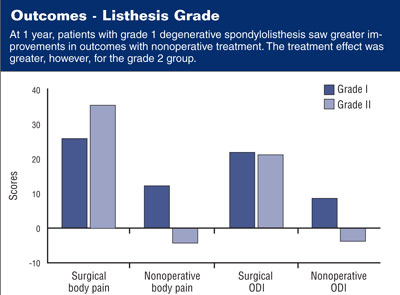Baseline radiographs not predictive of spondylolisthesis surgical outcomes
One key study finding: Hypermobility is not a contraindication for nonoperative treatment.
TORONTO — Baseline radiographic signs typically associated with
lumbar degenerative spondylolisthesis, such as slippage or reduced disc height,
were not useful in predicting patients’ outcomes after surgical treatment
for the condition,
 according to a
recent study.
according to a
recent study.
These results came from one of a trio of investigations that Adam M. Pearson, MD, presented at the North American Spine Society 23rd Annual Meeting, here, that used data culled from the multicenter Spine Patient Outcomes Research Trial (SPORT). The studies were conducted to draw further conclusions from the SPORT trial cohorts and help spine surgeons and patients make better treatment decisions, Pearson said.
According to the degenerative spondylolisthesis analysis, “Patients improved more with surgery than with nonoperative treatment regardless of their radiographic findings,” he said.
The as-treated analysis involved investigators from Dartmouth-Hitchcock Medical Center, Lebanon, N.H.; Rush University Medical Center, Chicago; and the Hospital for Special Surgery, New York who looked at a subset of the degenerative spondylolisthesis patient cohort from the SPORT study, which was conducted at 13 medical centers across the United States.
|
Image: Rapp S, Orthopedics Today |
Listhesis, height, stability
Baseline lateral radiographs were available for 222 patients, which were used to assess their disc height and amount of listhesis. The investigators also assessed hypermobility in 185 of those patients for whom baseline flexion/extension radiographs were available.
All patients had neurogenic claudication that caused pain for a minimum of 12 weeks and imaging consistent with degenerative spondylolisthesis.
Pearson said the usual exclusion criteria for such a study applied to this analysis.
Three measures
Investigators determined differences between pre- and postoperative levels in three key areas through 2 years postop, correlating them with baseline radiographs. They adjusted for potential confounding factors using longitudinal regression models.
Measures studied were degree of listhesis based on the Meyerding grade; disc height, where low height was 5 mm or less or about one-third of normal height; and intervertebral mobility with hypermobility defined as >10° rotation or 4 mm translation.
The primary outcome measures were SF-36 scores for bodily pain and function and Oswestry Disability Index (ODI) scores. Secondary outcome measures consisted of the stenosis bothersome index and low back pain bothersome scale.
Grade 1 slip group
Of the patients studied, 86% had Meyerding system grade-1 listhesis slips, 14% had grade-2 slips and 22% had low disc height. Spine hypermobility was diagnosed in 27% of patients, but the remainder had stable spines.
Surgical patients’ outcomes were similar at 1 year regardless of original listhesis grade, disc height or spine mobility. “However, the grade 1 group improved more with nonoperative treatment than the grade 2 group. This resulted in a greater treatment effect at 1 year, but these differences were no longer significant at 2 years,” Pearson said.
Furthermore, “Disc height was not generally associated with outcomes,” he added. One exception to that finding was that those patients with normal disc height showed more improvement on the spinal stenosis bothersomeness index 1 year after surgery vs. those with low disc height.

Source: Pearson AM |
Hypermobility
“Hypermobile patients improved more with nonoperative treatments than the stable patients. Hypermobility should not be a contraindication to nonoperative treatment,” Pearson noted.
He was surprised to see that more men had intervertebral hypermobility. Most hypermobile patients were treated with instrumented fusion, which suggested “surgeons actually took the flexion/extension X-rays into account when making their decisions.”
Limitations of the study were its observational nature, which increased the chances a confounding variable accounted for any changes detected, and it was not specifically powered to show outcomes differences for the variables studies, Pearson said.
Some differences also existed between the groups, such as more women than men had grade 2 listhesis. Likewise, more patients with grade 2 listhesis had low disc height, and those with low disc height were about 4 years older, with worse physical function, he said.
For more information:
- Adam M. Pearson, MD, can be reached at Dartmouth-Hitchcock Medical Center, 1 Medical Center Drive, Lebanon, NH 03756; 603-653-6038; e-mail: Adam.Pearson@Hitchcock.org. He has no financial conflicts to disclose related to products or companies mentioned in this article.
Reference:
- Pearson AM, Lurie JD, Blood E, et al. SPORT: Radiographic predictors of clinical outcomes following operative or nonoperative treatment of degenerative spondylolisthesis. #3. Presented at the North American Spine Society 23rd Annual Meeting. Oct. 15-18, 2008. Toronto.

